Proper calcination and firing on a bonfire of a cast iron cauldron
Before the first use after purchase, cookware made of cast iron and aluminum is recommended to be calcined, which subsequently extends its service life. Such work is carried out using special technology, it can be carried out both in a high-rise apartment, and in the country or on the territory of a private house. Proper calcination of the cauldron prevents cracking of dishes, which will subsequently retain their appearance for a long time.
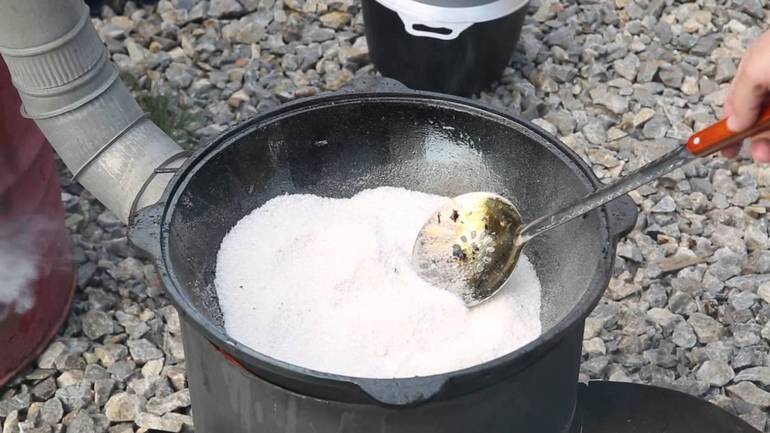
The main processing methods
There are several options to anneal a cauldron, and regardless of the technology chosen, such work should be carried out before the first use of such dishes. Such heat treatment of cast iron is not particularly difficult, therefore, every homeowner can do it.

The main ways to properly burn the cast-iron new cauldron:
- oil treatment;
- baking in the oven;
- bonfire heat treatment;
- calcination with salt.
At home, the easiest way to use a gas oven, but in the country or in a private house, it is recommended to perform processing using table salt at the stake. In the latter case, the maximum possible durability of such cast-iron utensils is ensured, which even after many years will not lose its original appearance.
Proper calcination of the boiler prevents the cooking of food from sticking to the walls and bottom. In particular, this is often noted with new dishes, when, not having processed it on a fire or in the oven, the homeowner risks putting such pans out of use literally after several of their use.
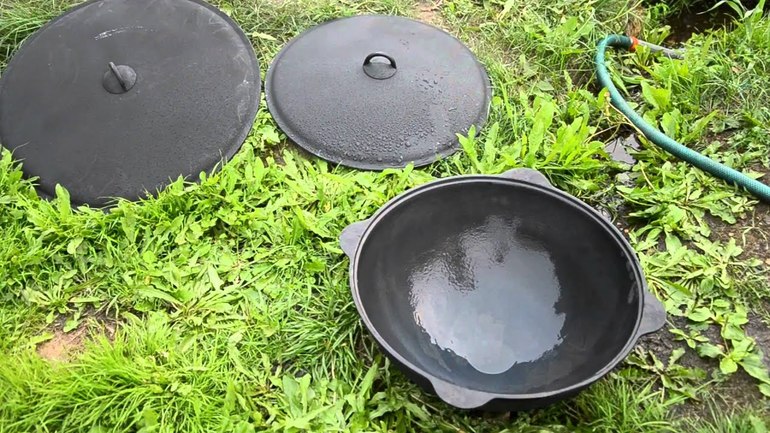
Without proper calcination of the tub, subsequently for a long time, when eating cooked dishes, you may feel an unpleasant aftertaste of rancid engine oil. To prevent this, it is necessary to properly prepare and burn cast iron and aluminum utensils using coarse salt.
Coarse Calcination
Salt processing can be performed both outdoors and in a high-rise apartment. It is recommended to use coarse salt for such work, which ensures the necessary quality of the work performed. But it is not recommended to use small “extra” or enriched with iodine for heat treatment of cast iron utensils.
You can burn the cauldron in the following way:
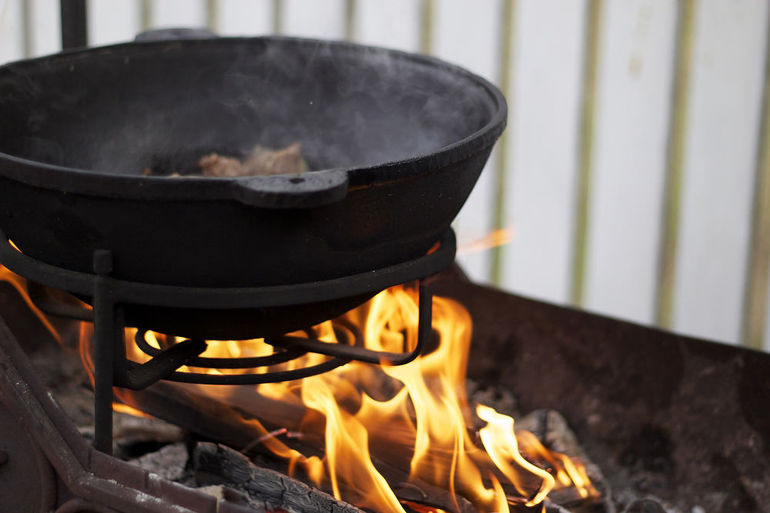
- The cast-iron boiler is rinsed inside and out with running water.
- The dishes are wiped dry with a towel.
- Inside the vat, 2-3 kg of salt is placed, depending on its size.
- The capacity is put on fire and can withstand about two hours.
- By the end of the salt calcination should get a brown color.
- After the procedure is complete, the dishes are cooled, the walls are wiped and washed thoroughly.
Such calcination is necessary to eliminate engine oil, which is invariably contained in numerous microcracks and barely visible pores in cast iron. Salt absorbs such oil during calcination, and subsequently cooking in a cauldron becomes completely safe. Dishes will not stick to the pan and will always be juicy and tasty.
Important. It is strictly forbidden to eat and use such salt left after processing the tub, as it is saturated with machine oil and other dangerous carcinogens.
Extra heat with oil
Cast iron is temperature-resistant, therefore, such cookware is able to withstand high temperatures. However, over time, rust may appear on the surface of the metal, to protect against which the famous cook Stalik Khankishiev recommends that when calcining the cauldron with coarse salt, an additional oil treatment is necessary. According to the hankish method, olive oil is used, but edible corn and sunflower oil are also excellent.
Step-by-step procedure for processing oil cauldron:
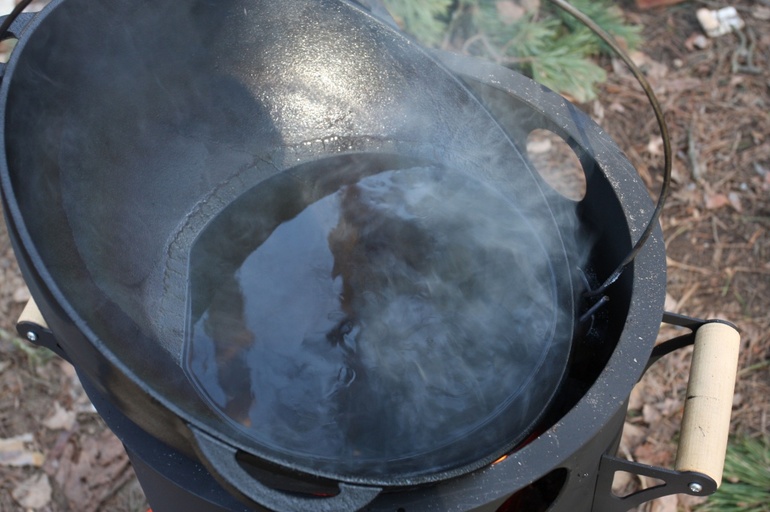
- After dry calcination, pour 1 liter of edible oil into a cast-iron tank.
- A metal container with fat is placed on medium heat.
- After 15−20 minutes, the oil in the cauldron boils.
- Gently tilt the dishes so that its walls are covered with grease.
- The cauldron is placed in the oven, preheated to 200 degrees.
- In the oven, dishes are aged for about two hours.
- After completion of the heat treatment, the cauldron is allowed to cool, all remaining oil must be washed with water and standard detergents.
When doing this treatment, it should be borne in mind that cast iron cookware does not tolerate sudden temperature changes. Therefore, pouring cold water into a red-hot cauldron is strictly prohibited, since the metal can become covered with numerous cracks. For washing dishes, use special household chemicals that do not contain abrasive components.
Oven steaming
Heat treatment and burning a cast-iron cauldron in the oven should be done in exceptional cases when it is not possible to carry out such work in the open air. When calcining a cast-iron cauldron, harmful vapors of burnt oil are released, which settle inside the oven and it is extremely difficult to get rid of them later. When firing in the apartment, you should periodically open the door to the oven and provide constant ventilation in the kitchen.
You can calcinate a cauldron in the oven as follows:
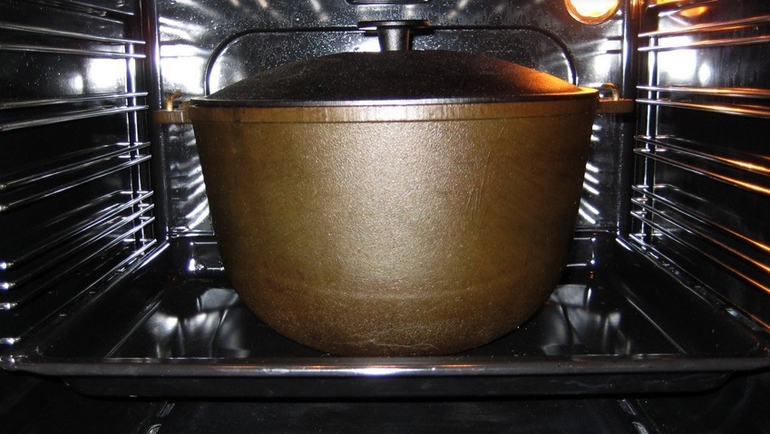
- The dishes are washed without detergents under running water.
- The oven should be heated to approximately 200 degrees.
- A cauldron is installed in the oven and the door is closed.
- As soon as the characteristic smoke starts from the metal, you should open the oven door every 10 minutes and be sure to ventilate the room.
- Complete the firing after the cessation of smoke. This usually takes several hours.
- The cauldron is cooled, washed under running water.
After completing such heat treatment, the oven should be washed using special chemicals, it will be useful to calcine the oven again, which will completely eliminate scale, grease and oil deposits, which are especially toxic. All gratings used for such calcination in the oven are washed using powerful household chemicals.
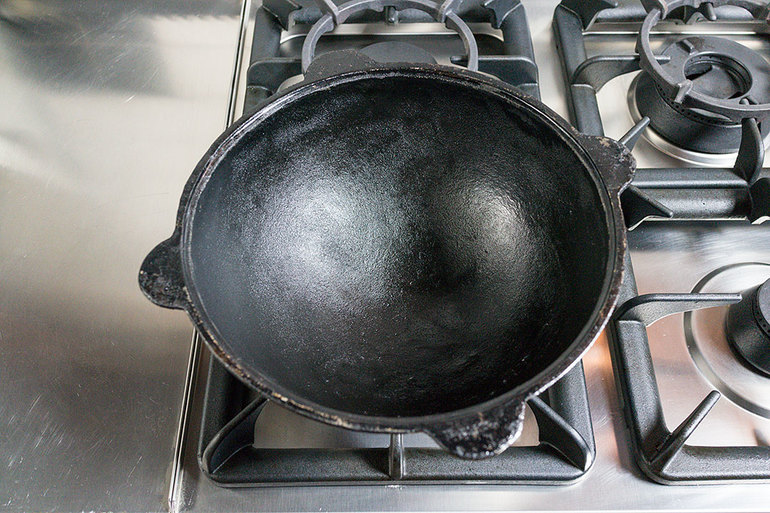
Bonfire
Processing a cauldron at a stake implies the presence of high temperatures, and such dishes are heated from the outside and from the inside. For such firing, wood should be used as fuel, but not coal, which emits soot, from which the cauldron can quickly blacken, and subsequently it will be already problematic to restore its original appearance.
It is possible to calcinate a cauldron from cast iron in the following way:
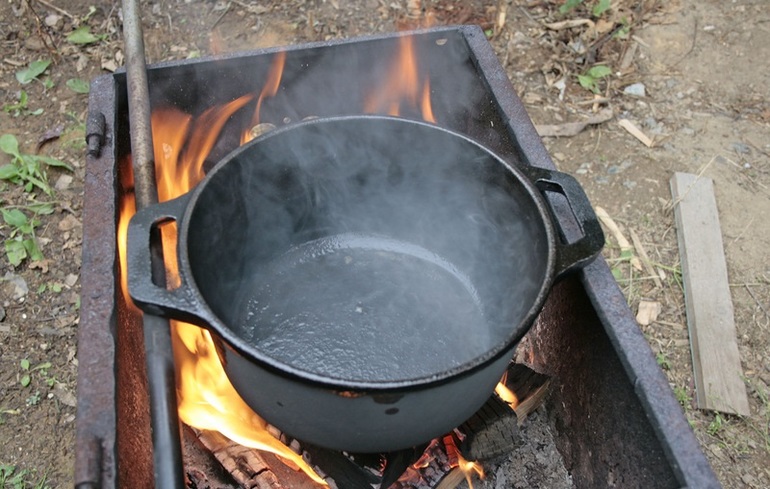
- Cast iron dishes are washed with household dishwashing detergents.
- The container is rinsed with water and wiped dry.
- Iron dishes are calcined over a fire for about 3 hours, maintaining a strong fire.
After completing the calcination, the dishes are cooled, and then washed with water. During this treatment, many harmful fumes of engine oil appear, inhalation of such smoke should be avoided, keeping small children out of the fire. Subsequently, cooking on fire is not recommended. Coals should be collected and disposed of.
Preparation for use
When choosing a method of calcining a cauldron, one should take into account both the possibilities of the homeowner and the material from which such dishes are made.The heat treatment time depends, including on the thickness of the metal and the size of the container. Subsequently, when storing the cauldron, it should be remembered that it is undesirable to cover it with a lid, and after each use it is necessary to wash the dishes.
When preparing a cast iron cauldron for use, it should be calcined over an open fire, remove the remaining oil with gel detergents, running water and a dry towel. Next, they process it with vegetable edible oil, which protects the metal from corrosion, and after completion of such calcination, the cauldron is again washed with warm water and wiped clean with a towel.
Aluminum cauldrons are extremely critical to the temperature of their processing, so you can brew them in the oven or on the stove, where the flame temperature will not exceed 150 degrees. When washing such a metal cauldron, you should use only laundry soap and kitchen sponges. The use of any powder mixtures or soda is strictly prohibited.
Homeowner Recommendations
If safety rules were violated during such firing of the cauldron and oil caught fire inside the tank, then, if possible, quickly remove the fire or turn off the stove, and use earth or sand to extinguish. A lighted cauldron can also be covered with a lid, a baking sheet or other container, which prevents the supply of oxygen necessary for burning a fire.
It should be remembered that such oil fires are extremely dangerous, the flame spreads quickly, and it can be difficult to deal with it. In no case should you move the cauldron, since. In such a case, there is a danger of overturning it and spilling oil, after which it will be impossible to cope with such a fire independently. You should not put out a lighted cauldron with water, since such a thing is simply useless, and will only lead to quick cracking, and in the future it will be impossible to use such dishes.
- How to choose a vacuum cleaner taking into account the characteristics of the house and coatings?
- What to look for when choosing a water delivery
- How to quickly create comfort at home - tips for housewives
- How to choose the perfect TV - useful tips
- What to look for when choosing blinds
- What should be running shoes?
- What useful things can you buy in a hardware store
- Iphone 11 pro max review
- Than iPhone is better than Android smartphones

